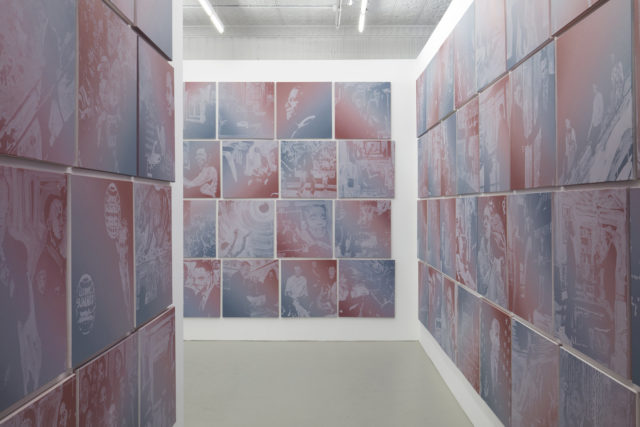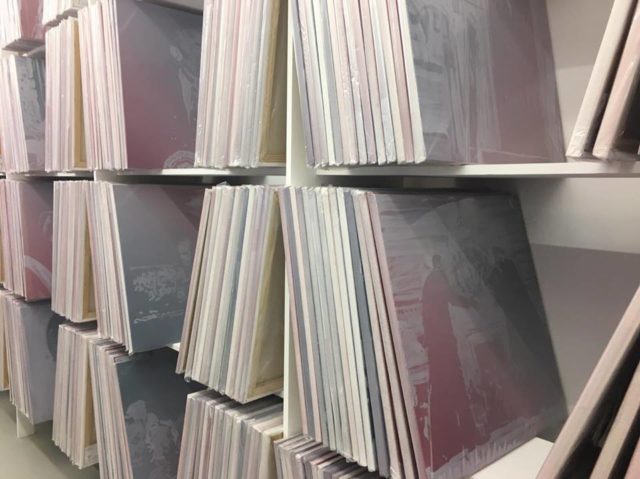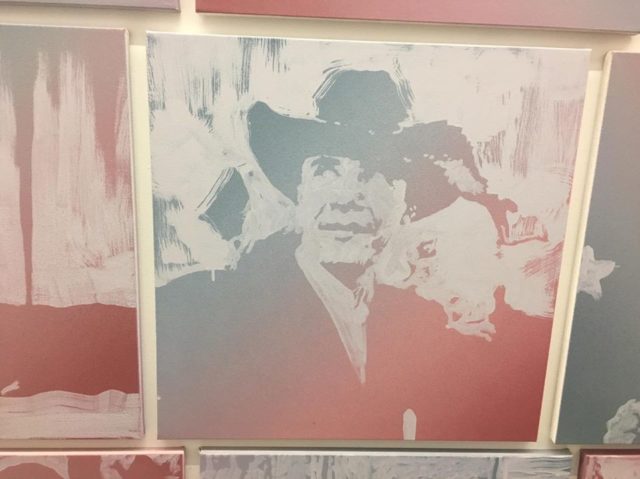
Installation view of Rob Pruitt’s The Obama Paintings at Gavin Brown’s Enterprise (Photo: Thomas Mueller; Courtesy the artist and Gavin Brown’s Enterprise, New York/Rome)
Rob Pruitt: The Obama Paintings
Gavin Brown’s Enterprise
291 Grand Street
New York, NY
On view until December 18, 2016
Sometimes an artist’s project is so timely that it doesn’t matter if the concept is hokey. Nowhere is this more apparent than in Rob Pruitt’s The Obama Paintings, which is currently on view at Gavin Brown’s Enterprise.
Starting with Obama’s inauguration in 2009, Pruitt embarked on an eight-year long project to paint Obama every day of his two-term presidency. These red, white and blue-toned works might look cheesy in another political moment. But, in the context of the looming Trump administration, The Obama Paintings provides a meaningful opportunity to reflect on Obama’s presidential legacy, as well as the forthcoming exit of this empathetic and considerate leader. I’ll admit, I got a little choked-up in the gallery.
The dire relevancy of this series wasn’t lost on Gavin Brown. After the shock of the election results, the gallery altered their original plans to exhibit Pruitt’s cheeky Rob Pruitt’s Official Art World / Celebrity Look-alikes Series®©™, swapping that show with The Obama Paintings. With this last minute change, the gallery and Pruitt avoided looking tone-deaf by replacing art world naval-gazing with a direct response to American politics now. It was a wise choice.

Installation view of Rob Pruitt’s The Obama Paintings (photo by author)
One of the strengths of The Obama Paintings is its sheer expanse. There’s no easing into this exhibition. Entering the gallery, viewers are immediately confronted by walls upon walls of square Obama’s packed tight from floor to ceiling. While the series will eventually conclude with 2,922 paintings by January 20, the show still requires numerous temporary walls to showcase the approximately 2,884 paintings. There are also shelves containing stacks of plastic-wrapped paintings that couldn’t fit on the walls. Forcing viewers to maneuver through this claustrophobic maze of paintings, the show feels like a maniacally obsessive shrine to the President.
According to a 2015 interview with ArtNews, Pruitt sources the Obama imagery every morning from the previous day’s news. Perhaps because of this daily strategy, the paintings’ content ranges from iconic moments of the Obama presidency to more mundane and even, silly images. There are somber and serious representations of Obama meeting with world leaders, bestowing Medals of Honor and speaking at campaign rallies. Conversely, I also spotted popular viral photographs such as Obama shirtless in Hawaii, palling around with his buddy Joe Biden and playing with children in the Oval Office. Beyond just the President, a familiar cast of characters continually reappears throughout the exhibition including Michelle Obama, his daughters Sasha and Malia and the Clintons.

Selection of Rob Pruitt’s The Obama Paintings (photo by author)
Despite the differences in imagery, Pruitt renders all the paintings in a uniform style. The gradient red, white and blue creates an almost abstract effect, particularly with the white paint that outlines the figures. Granted, each painting is not that successful on its own. The patriotic color scheme could not be more on the nose and the white paint has the, presumably, unintended effect of whitewashing America’s first black president.
In fact, the entire concept risks looking like a hackneyed attempt at creating political art while sidestepping pointed partisan critique. But, this open-endedness, coupled with our terrifying political times, not only overpowered the paintings’ aesthetic flaws, but allowed space for viewers to contemplate the last eight years. I watched a group of gallery-goers very slowly make their way around the room, pausing to point out significant historical events. Even I, a typically speedy art viewer, spent much longer in the gallery than I normally would, taking in the multiplicity of representations of Obama.

Selection of Rob Pruitt’s The Obama Paintings (photo by author)
More than a portrait of the presidential office and its duties, The Obama Paintings is a representation of how one man handled the pressures and responsibilities of the presidency. In one painting, he’s emotional as he tears up at a press conference about the Sandy Hook shootings. In another, he’s powerful and passionate while speaking at a campaign rally for Hillary Clinton. He’s a goofy dad in yet another while mugging to the camera in a cowboy hat.
For better or worse, America is–both at home and in the eyes of the rest of the world–defined by its president. Granted, I imagine that the effect of these paintings would be completely different if Hillary Clinton won on November 8. But, with Trump’s upcoming administration, the President’s tender humanity, as depicted in Pruitt’s portraits, feels like the closing chapter of a certain era of contemporary American history.
Looking at The Obama Paintings, I couldn’t help but wonder what a companion Trump series would look like (surreal and terrifying), as well as imagine Pruitt’s final painting of Obama turning the White House over to Trump. That will undoubtedly make for a chilling end to the series. At a time when the country feels doomed with the daily nightmare of Trump’s Cabinet picks and his Twitter shock tactics, The Obama Paintings are a proper memorial to the country and Obama presidency. I fear we’ll be remembering this series with a combination of nostalgia and regret during the next four years.


Comments on this entry are closed.